Using Dual Isotopes of Nitrate to Identify the Source of Nitrogen Pollution in the Songhua River Basin, Northeast China
Abstract
1. Introduction
2. Materials and Methods
2.1. Study Area
2.2. Analytical Procedures
| Pollution Source | δ15N-NO3/‰ | Reference | |
|---|---|---|---|
| Range | Mean | ||
| NO3− deposition from atmosphere | −7.0 to 8.0 | 0.5 | [28,29] |
| NH4+-N of rain | −10.0 to 3.0 | −3.5 | [30] |
| Soil organic nitrogen | 2.0 to 9.0 | 5.5 | [30,31] |
| Sewage | 10.0 to 18.0 | 14.0 | [30,31,32] |
| Manure wastewater | 8.0 to 25.0 | 16.5 | [30,33] |
| Nitrogen fertilizer | −3.0 to 4.0 | 0.5 | [34,35,36,37] |
2.3. Measurement of Isotope Calculations
3. Results and Discussion
3.1. Source Analysis of Nitrogen in Low Flow Season
3.1.1. Qualitative Source Analysis
- (1)
- The Nen River Basin includes NJ02 and NJ01. NJ02 had values of δ15N-NO3 and δ18O-NO3 of 10.08‰ and −0.63‰, respectively, and NJ01 had values of 10.06‰ and −1.79‰, respectively. The source of nitrogen at these two sites is sewage and manure wastewater.
- (2)
- The upper reach of the SHR from Jilin city to Songyuan city has eight research sections, and the values of δ15N-NO3 and δ18O-NO3 ranged from 7.34‰ to 11.27‰ and −2.35‰ to −0.67‰, respectively. Among them, the nitrogen source to ES01, upstream of Jilin city, is mainly soil organic nitrogen, while the nitrogen source to ES04 and ES17, downstream of Jilin city and Songyuan city, is mainly domestic and manure sewage.
- (3)
- The Yitong River Basin flows through Changchun city. The values of δ15N-NO3 and δ18O-NO3 in the eight sections in the Yitong River ranged from 11.59‰ to 15.46‰ and from −2.42‰ to 3.17‰, respectively. Domestic and manure sewage is the main source of nitrogen to this portion of the river basin.
- (4)
- There are 10 research sections in main stream of the Harbin region. The values for δ15N-NO3 and δ18O-NO3 ranged from 6.66‰ to 13.76‰ and 2.17‰ to 65.70‰, respectively. According to the isotopic values, domestic and manure sewage and soil organic nitrogen are the two main sources of nitrogen in this region. By comparing the values upstream and downstream of Harbin, the main source of nitrogen changes from soil organic nitrogen to domestic and manure sewage after the inflow of the Ashi River, which may be related to the sewage treatment plant along the Ashi River. In addition, according to the isotopic analysis, the main source of nitrogen in the Hulan River is atmospheric deposition.
- (5)
- There are seven research sections in the main stream of Yilan city to Jiamusi city region, where the δ15N-NO3 and δ18O-NO3 values ranged from 7.68‰ to 10.19‰ and −5.82‰ to −1.92‰, respectively. Soil organic nitrogen and domestic and manure sewage are the main nitrogen sources in this region. Nitrogen in the Mudan River mainly comes from soil organic nitrogen, and nitrogen in the Woken River and upstream of the Jiamusi section mainly comes from domestic and manure sewage, which may be related to the urban domestic sewage input of Yilan city and Jiamusi city.
3.1.2. Contribution Rates
3.2. Source Analysis of N in the High Flow Season
3.2.1. Qualitative Source Analysis
- (1)
- The δ15N-NO3 and δ18O-NO3 values for NJ02 in the Nen River region were 3.70‰ and −1.90‰, and the values for NJ01 were 2.41‰ and −3.83‰, respectively. Nitrogen in the two sections of the Nen River during the high flow season is mainly from nitrogen fertilizer and soil organic nitrogen input.
- (2)
- The δ15N-NO3 and δ18O-NO3 values from Jilin city to the Songyuan city region of the upper reach of the SHR were 7.31‰ to 10.67‰ and −2.04‰ to 3.04‰, respectively. The nitrogen at ES01 is mainly from soil organic nitrogen, while the nitrogen in the downstream sections of Jilin city is mainly from domestic and manure sewage.
- (3)
- The δ15N-NO3 and δ18O-NO3 values for the eight sections of the Yitong River ranged from 4.61‰ to 14.24‰ and 1.64‰ to 8.03‰, respectively. Among them, the source of nitrogen of ES11 is soil organic nitrogen, as upstream of ES11 is the Xinlicheng Reservoir, which has little influence because of the water source area. The urban area of Changchun city and Kaoshan town are affected by domestic and manure sewage. In addition, nitrogen in the water of ES14 and ES15 is affected by denitrification, because the linear enrichment ratio between δ15N-NO3 and δ18O-NO3 of ES14 and ES15 is 1.54:1 and 1.77:1.
- (4)
- The δ15N-NO3 values for the eight main stream sections in the main stream of the Harbin region ranged from 2.07‰ to 9.33‰, and the δ18O-NO3 values ranged from −2.84‰ to 3.38‰. The source of nitrogen is affected by soil organic nitrogen, domestic and manure sewage, and nitrogen fertilizer.
- (5)
- The δ15N-NO3 and δ18O-NO3 values for the main stream from Yilan city to Jiamusi region ranged from 2.47‰ to 7.48‰ and −3.99‰ to 0.10‰, respectively, where the main source is soil organic nitrogen, followed by nitrogen fertilizer. The main source of nitrogen in the Mudan River is soil organic nitrogen, and the main source of nitrogen at GL14 is nitrogen fertilizer.
3.2.2. Contribution Rates
3.3. Source Analysis of N in the Flat Flow Season
3.3.1. Qualitative Source Analysis
- (1)
- The values for δ15N-NO3 and δ18O-NO3 at the cross area of the Nen River, Second SHR, and the main stream of the SHR ranged from 5.20‰ to 9.33‰ and −7.48‰ to 1.32‰, respectively. The nitrogen at NJ01 and GL02 is mainly from soil organic nitrogen. The nitrogen at ES17 is mainly affected by domestic and manure sewage.
- (2)
- The values for δ15N-NO3 and δ18O-NO3 in the Yitong River sections ranged from 1.52‰ to 7.18‰ and −14.26‰ to −10.14‰, respectively. Nitrogen fertilizers and soil organic nitrogen are the main sources of nitrogen in the Yitong River during the flat flow season.
- (3)
- The δ15N-NO3 and δ18O-NO3 of the Harbin region of the main stream of the SHR ranged from 3.00‰ to 11.15‰ and −2.88‰ to −0.01‰. The nitrogen upstream of the city comes from soil organic nitrogen, the nitrogen at GL05 of the Ashi River comes from domestic and manure sewage, and the main source of nitrogen at GL07 of the Hulan River is nitrogen fertilizer and soil organic nitrogen.
- (4)
- The values of δ15N-NO3 and δ18O-NO3 in the region from Yilan city to Jiameri of the main stream ranged from 5.96‰ to 14.55‰ and −9.06‰ to 2.33‰, respectively. The Mudan River is mainly affected by soil organic nitrogen from the natural environment. The nitrogen source at GL14 is domestic and manure sewage, which may be related to the input of the urban point source in Yilan city.
3.3.2. Contribution Rates
4. Conclusions
Author Contributions
Funding
Institutional Review Board Statement
Informed Consent Statement
Acknowledgments
Conflicts of Interest
References
- Jiang, M.C.; Wang, Y.Y.; Yang, Q.; Meng, F.S.; Yao, Z.P.; Cheng, P.X. Assessment of surface water quality using a growing hierarchical self-organizing map: A case study of the Songhua River Basin, northeastern China, from 2011 to 2015. Environ. Monit. Assess. 2018, 190, 260. [Google Scholar] [CrossRef]
- Zhang, L.S.; Wang, Y.Y.; Meng, F.S.; Liu, T.L.; Zhou, Y.X. Water quality assessment of ammonia to aquatic life in Songhua River. Res. Environ. Sci. 2012, 25, 1344–1350. (In Chinese) [Google Scholar]
- Zheng, Q.Y.; Liu, S.; Wan, L.H.; Li, Y.Q.; Qi, S.Q. Water environmental quality assessment and source apportionment in Harbin section of Songhua River. Res. Environ. Sci. 2018, 31, 507–513. (In Chinese) [Google Scholar]
- Meng, F.S.; Wang, Y.Y.; Zhang, L.S.; Cheng, P.X.; Xue, H.; Meng, D.B. Organic pollutant types and concentration changes of the water from Songhua River, China, in 1975–2013. Water Air Soil Pollut. 2016, 227, 214. [Google Scholar] [CrossRef]
- Zhang, L.S.; Wang, Y.Y.; Meng, F.S.; Liu, T.L.; Ma, G.W.; Zhou, Y.X.; Liu, Y. Characteristics of Ammonia-N Pollution in Songhua River. Environ. Sci. Technol. 2013, 10, 43–48. (In Chinese) [Google Scholar]
- Lin, L.Y.; Shi, Y.; Luo, H.J.; Zhang, Y.J.; Yu, Y.; Chen, Y.H. Study on the characteristics of water pollution change of Songhua River Basin in 2001–2015. Environ. Monit. Chin. 2016, 32, 58–62. (In Chinese) [Google Scholar]
- Li, F.Y.; Wang, J.Y.; Cao, T.T.; Cui, C.W. Analyzing the reason of NH3-N pollution in icebound of Harbin section of Songhua River. Chem. Eng. 2016, 30, 28–30. (In Chinese) [Google Scholar]
- Li, Y.Z.; Chen, H.Y.; Sun, W.C. Load estimation and source apportionment of nitrogen, phosphorus and COD in the basin of Lake Baiyang. China Environ. Sci. 2021, 41, 366–376. (In Chinese) [Google Scholar]
- Barbieri, M. Isotopes in Hydrology and Hydrogeology. Water 2019, 11, 291. [Google Scholar] [CrossRef]
- Yue, F.J.; Li, S.L.; Liu, C.Q.; Zhao, Z.Q.; Hu, J. Using dual isotopes to evaluate sources and transformation of nitrogen in the Liao River, northeast China. Appl. Geochem. 2013, 36, 1–9. [Google Scholar] [CrossRef]
- Yue, F.J.; Li, S.L.; Hu, J. The Contribution of Nitrate Sources in Liao Rivers, China, Based on Isotopic Fractionation and Bayesian Mixing Model. Procedia Earth Planet. Sci. 2015, 13, 16–20. [Google Scholar] [CrossRef][Green Version]
- Li, C.; Li, S.L.; Yue, F.J.; Liu, J.; Zhong, J.; Yan, Z.F.; Zhang, R.C.; Wang, Z.J.; Xu, S. Identification of sources and transformations of nitrate in the Xijiang River using nitrate isotopes and Bayesian model. Sci. Total Environ. 2019, 646, 801–810. [Google Scholar] [CrossRef] [PubMed]
- Ma, G.W.; Wang, Y.Y.; Xiang, B.; Hu, Y.; Liu, Y.P.; Wang, T.M.; Yu, H.B. Nitrogen pollution characteristics and source analysis using nitrogen isotope in Ashi River water system during dry season. Environ. Pollut. Control 2014, 36, 6–11. (In Chinese) [Google Scholar]
- Phillips, D.L.; Koch, P.L. Incorporating concentration dependence in stable isotope mixing models. Oecologia 2002, 130, 114–125. [Google Scholar] [CrossRef] [PubMed]
- Phillips, D.L.; Newsome, S.D.; Gregg, J.W. Combining sources in stable isotope mixing models: Alternative methods. Oecologia 2005, 144, 520–527. [Google Scholar] [CrossRef] [PubMed]
- Fu, J.X.; Shan, J.J.; Yuan, Y.S.; Wu, R.; Fang, Z.; Sun, J.P. Study on nitrogen source of shenfu section of Hunhe River Basin based on δ15N and δ18O. J. Shenyang Jianzhu Univ. (Nat. Sci.) 2018, 34, 165–175. (In Chinese) [Google Scholar]
- Widory, D.; Kloppmann, W.; Chery, L.; Bonnin, J.; Rochdi, H.; Guinamant, J.L. Nitrate in groundwater: An isotopic multi-tracer approach. J. Contam. Hydrol. 2004, 72, 165–188. [Google Scholar] [CrossRef]
- Chen, W.Q.; Chen, W.C.; Rao, H.H.; Zhang, L.P.; Hong, H.S. An improved ion-exchange/diffusion method for 15N isotope tracing analysis of nitrate in surface waters from watersheds. J. Environ. Sci. 2010, 22, 784–788. [Google Scholar] [CrossRef][Green Version]
- Meghdadi, A.; Javar, N. Quantification of spatial and seasonal variations in the proportional contribution of nitrate sources using a multi-isotope approach and Bayesian isotope mixing model. Environ. Pollut. 2018, 235, 207–222. [Google Scholar] [CrossRef]
- Zhen, S.C.; Zhu, W. Analysis of isotope tracing of domestic sewage sources in Taihu Lake—A case study of Meiliang Bay and Gonghu Bay. Ecol. Indic. 2016, 66, 113–120. [Google Scholar] [CrossRef]
- Chen, Z.X. Using Nitrogen and Oxygen Isotopic Compositions in Dissolved Nitrate to Identity Nitrate Sources in Taihu Lake and Chaohu Lake, China. Ph.D. Thesis, University of Science & Technology of China, Hefei, China, 2012. (In Chinese). [Google Scholar]
- Wang, J.; Ye, Y.; Wang, Y.Q.; Wang, D.Z.; Lv, G.A.; Guo, X.S. Using δ15N and δ18O values to identify sources of nitrate in the Dianbu River in the Chaohu Lake Basin. J. Hydraul. Eng. 2017, 48, 1195–1205. (In Chinese) [Google Scholar]
- Li, X.F.; Zhang, M.J.; Ma, Q.; Li, Y.J.; Wang, S.J.; Wang, B.L. Characteristics of stable isotopes in precipitation over northeast China and its water vapor sources. Environ. Sci. 2012, 33, 2924–2931. (In Chinese) [Google Scholar]
- Chen, Z.X.; Liu, G.; Liu, W.G.; Lam, M.H.W.; Liu, G.J.; Yin, X.B. Identification of nitrate sources in Taihu Lake and its major inflow rivers in China, using δ15N-NO3− and δ18O-NO3− values. Water Sci. Technol. 2012, 66, 536–542. [Google Scholar] [CrossRef] [PubMed]
- Meng, Z.L.; Yang, Y.G.; Qing, Z.D.; Jiao, W.T. Isotopic tracing for nitrate pollution process of water body in the lower reaches of Fenhe River. China Environ. Sci. 2017, 37, 1066–1072. (In Chinese) [Google Scholar]
- Wu, W.H.; He, X.J.; Wu, H.L.; Wang, X.Z.; Shen, J. Identification of sources of nitrate in the Yongan River with isotopic technology. J. Ecol. Rural Environ. 2016, 32, 802–807. (In Chinese) [Google Scholar]
- Kang, P.P.; Xu, S.G.; Yu, S.Q. Analysis of influence of underground reservoir on nitrogen distribution through tracing of isotope source. Water Resour. Prot. 2016, 32, 79–84. (In Chinese) [Google Scholar]
- Bu, H.M.; Song, X.F.; Zhang, Y.; Meng, W. Sources and fate of nitrate in the Haicheng River basin in Northeast China using stable isotopes of nitrate. Ecol. Eng. 2017, 98, 105–113. [Google Scholar] [CrossRef]
- Zhang, J.P.; Song, X.M. Research advances on tracking multiply sources of nitrate by using stable isotopes in water. Environ. Sci. Technol. 2014, 6, 71–75. (In Chinese) [Google Scholar]
- Hu, Y.; Wang, Y.Y.; Teng, Y.G.; Xiang, B.; Ma, G.W.; Fang, G.L. Source apportionment of non-point source nitrogen pollution in Ashi River Basin using δ15N Technique. J. Agro-Environ. Sci. 2015, 12, 2327–2335. (In Chinese) [Google Scholar]
- Yue, F.J.; Liu, C.Q.; Li, S.L.; Zhao, Z.Q.; Liu, X.L.; Ding, H.; Liu, B.J.; Zhong, J. Analysis of δ15N and δ18O to identify nitrate sources and transformations in Songhua River, Northeast China. J. Hydrol. 2014, 519, 329–339. [Google Scholar] [CrossRef]
- Zhang, Y.; Li, F.D.; Zhang, Q.Y.; Li, J.; Liu, Q. Tracing nitrate pollution sources and transformation in surface- and ground-waters using environmental isotopes. Sci. Total Environ. 2014, 490, 213–222. [Google Scholar] [CrossRef]
- Ma, Z.F.; Yang, Y.; Lian, X.Y.; Jiang, Y.H.; Xi, B.D.; Peng, X.; Yan, K. Identification of nitrate sources in groundwater using a stable isotope and 3DEEM in a landfill in Northeast China. Sci. Total Environ. 2016, 563–564, 593–599. [Google Scholar]
- Yang, B.S.; Wang, H.; Jiang, Y.K.; Dong, F.; He, X.H.; Lai, X.S. Combing δ15N and δ18O to identify the distribution and the potential sources of nitrate in human-impacted watersheds, Shandong, China. RSC Adv. 2018, 8, 23199–23205. [Google Scholar] [CrossRef]
- Minet, E.P.; Goodhue, R.; Meier-Augenstein, W.; Kalinb, R.M.; Fenton, O.; Richards, K.G.; Coxon, C.E. Combining stable isotopes with contamination indicators: A method for improved investigation of nitrate sources and dynamics in aquifers with mixed nitrogen inputs. Water Res. 2017, 124, 85–96. [Google Scholar] [CrossRef] [PubMed]
- Yang, Z.; Chen, J.F.; Li, H.L.; Jin, H.Y.; Gao, S.Q.; Ji, Z.Q.; Zhu, Y.; Ran, L.H.; Zhang, J.J.; Liao, Y.B.; et al. Sources of nitrate in Xiangshan Bay (China),as identified using nitrogen and oxygen isotopes. Estuar. Coast. Shelf Sci. 2018, 207, 109–118. [Google Scholar] [CrossRef]
- Ding, J.T.; Xi, B.D.; Gao, R.T.; He, L.S.; Liu, H.L.; Dai, X.L.; Yu, Y.J. Identifying diffused nitrate sources in a stream in an agricultural field using a dual isotopic approach. Sci. Total Environ. 2014, 484, 10–18. [Google Scholar] [CrossRef]
- Lentz, R.D.; Lehrsch, G. Temporal changes in δ18O and δ15N of nitrate nitrogen and H2O in shallow groundwater: Transit time and nitrate-source implications for an irrigated tract in southern Idaho. Agric. Water Manag. 2019, 212, 126–135. [Google Scholar] [CrossRef]
- Archana, A.; Thibodeau, B.; Geeraert, N.; Xu, M.N.; Kao, S.J.; Baker, D.M. Nitrogen sources and cycling revealed by dual isotopes of nitrate in a complex urbanized environment. Water Res. 2018, 142, 459–470. [Google Scholar] [CrossRef]
- Saccon, P.; Leis, A.; Marca, A.; Kaiser, J.; Campisi, L.; Böttcher, M.E.; Savarino, J.; Escher, P.; Eisenhauer, A.; Erbland, J. Multi-isotope approach for the identification and characterisation of nitrate pollution sources in the Marano lagoon (Italy) and parts of its catchment area. Appl. Geochem. 2013, 34, 75–89. [Google Scholar] [CrossRef]

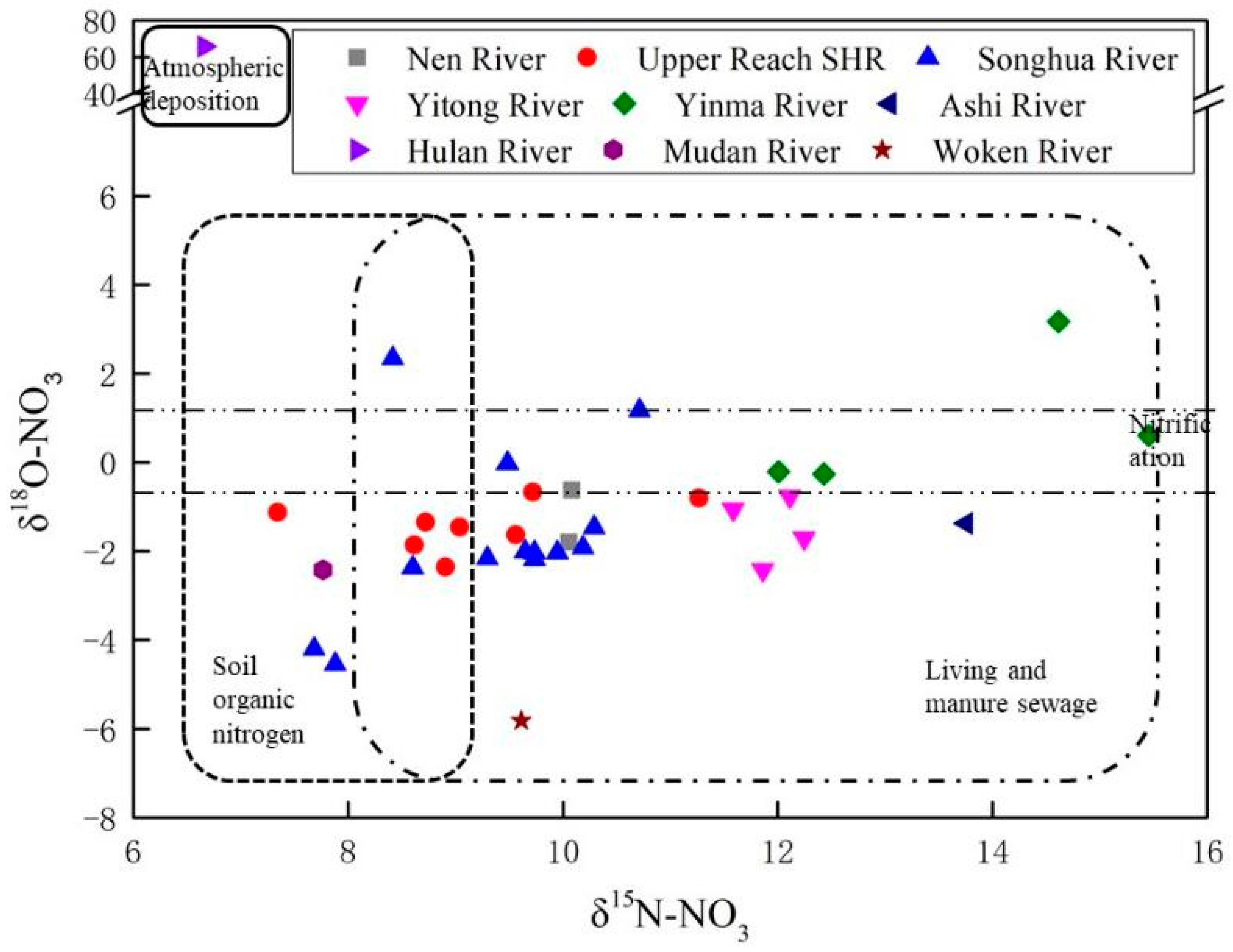
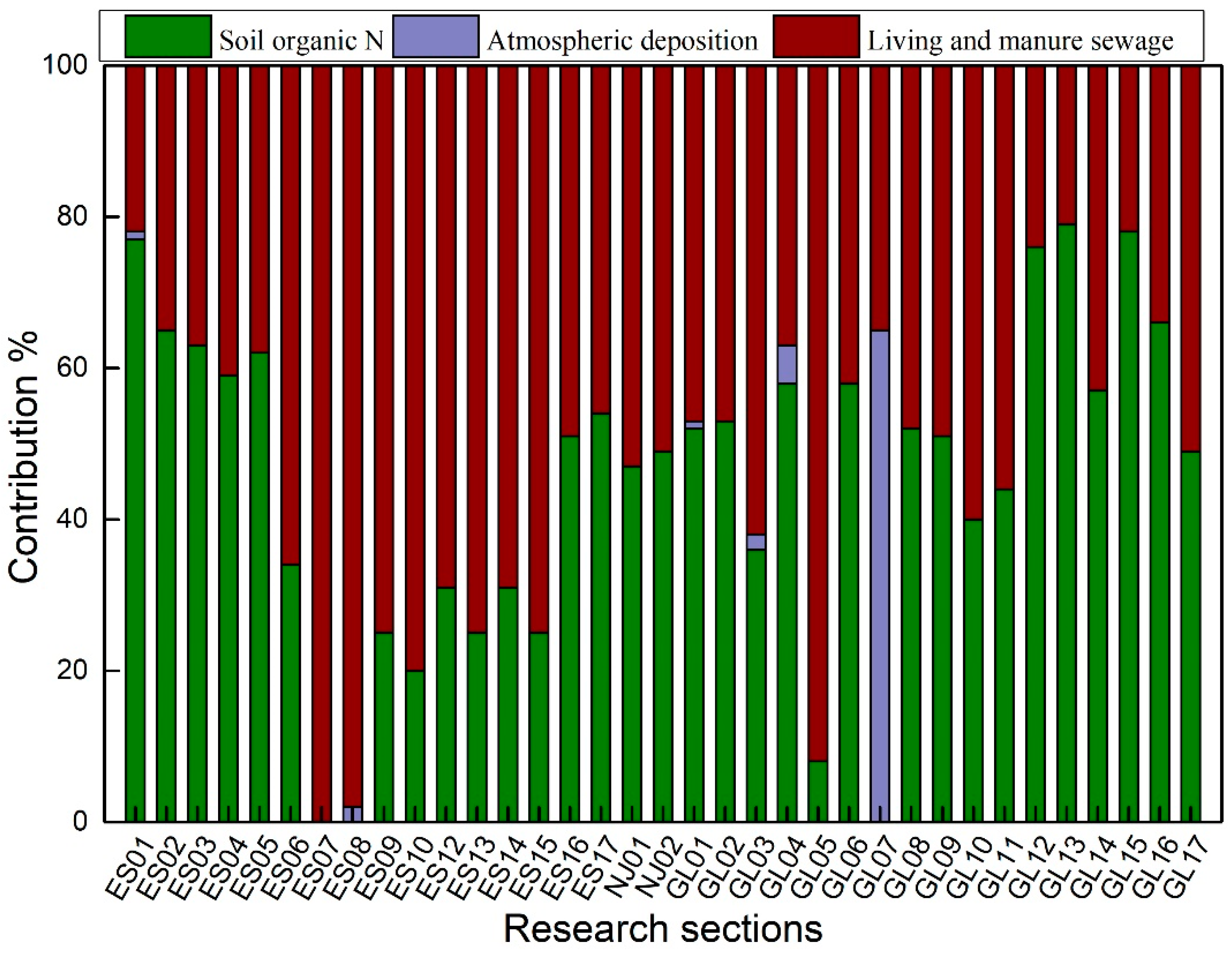
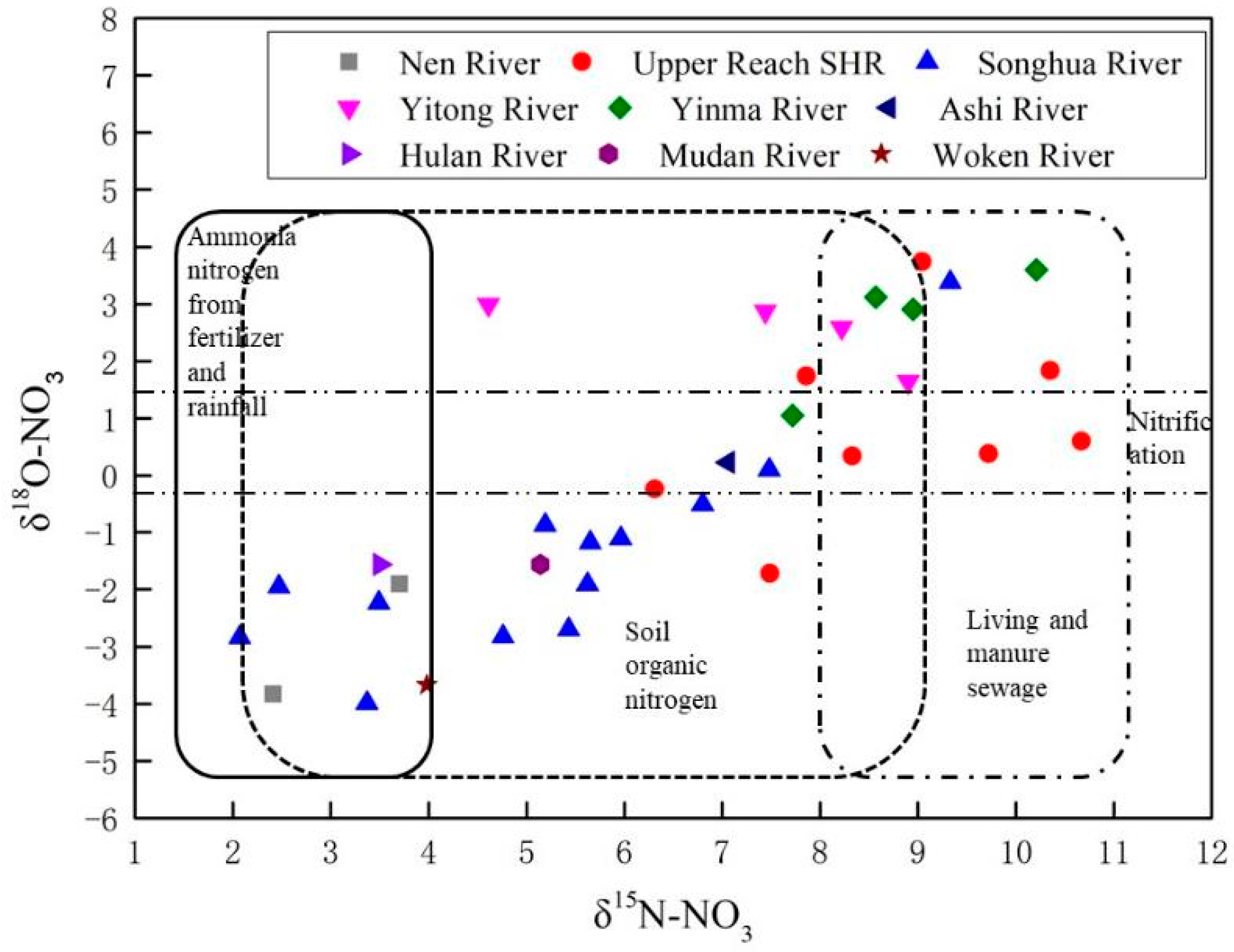

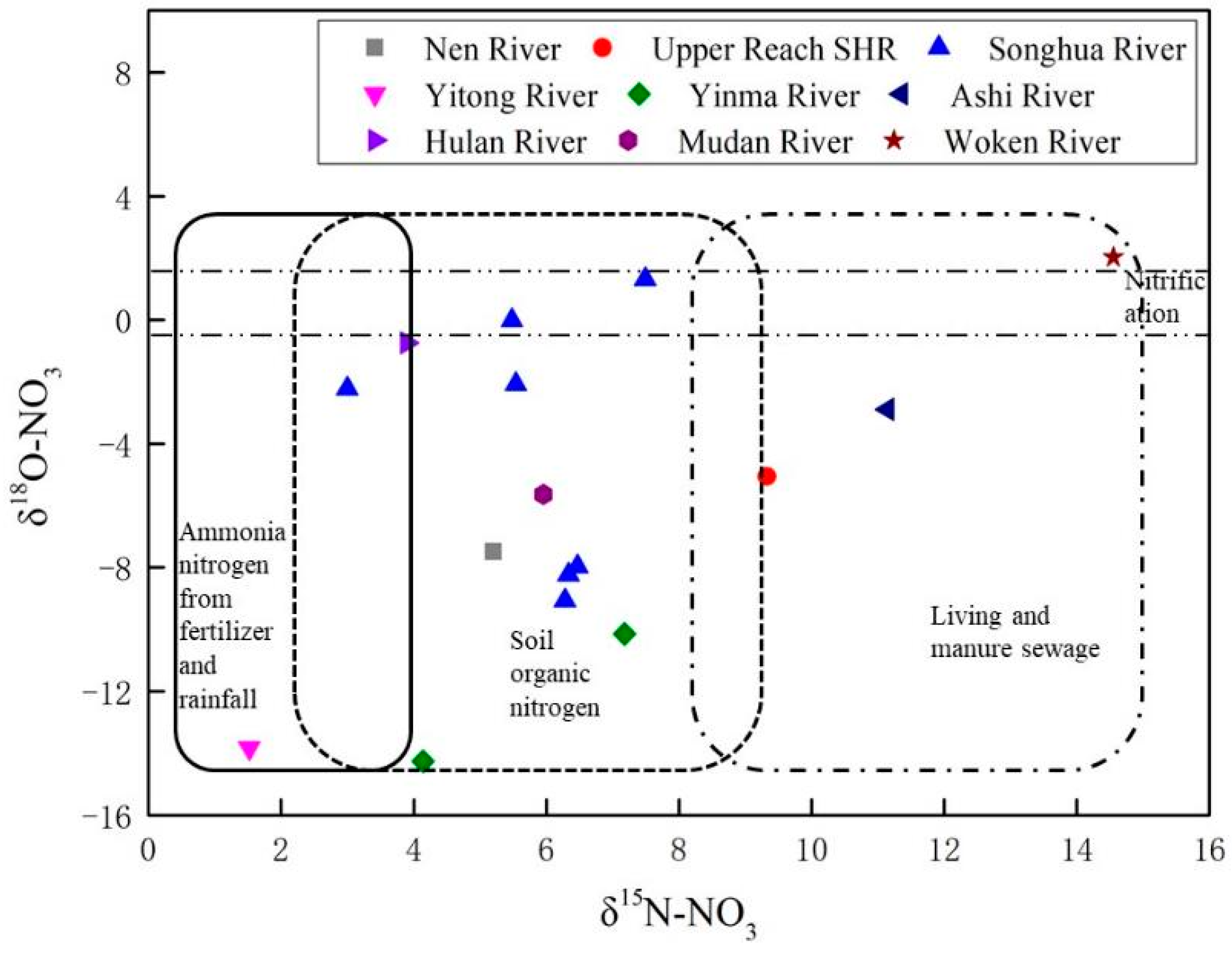
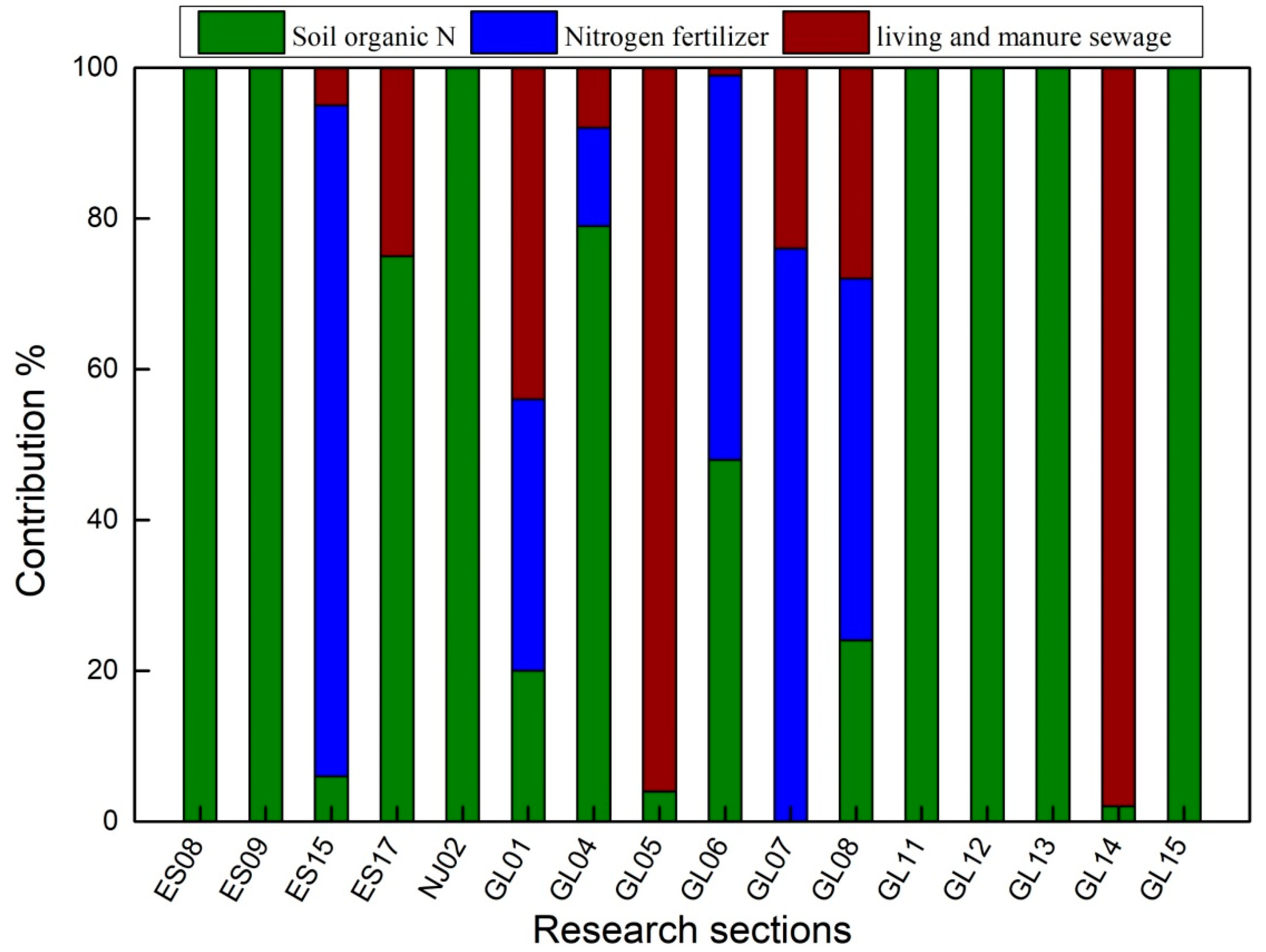
| Number | High Flow Season | Low Flow Season | Flat Flow Season | ||||||
|---|---|---|---|---|---|---|---|---|---|
| NO3−-N | δ15N-NO3 | δ18O-NO3 | NO3−-N | δ15N-NO3 | δ18O-NO3 | NO3−-N | δ15N-NO3 | δ18O-NO3 | |
| ES01 | 1.70 | 7.49 | −1.72 | 2.23 | 7.34 | −1.13 | ND | ND | ND |
| ES02 | 3.15 | 10.67 | 0.60 | 2.32 | 8.62 | −1.86 | ND | ND | ND |
| ES03 | 3.05 | 9.72 | 0.38 | 2.78 | 8.72 | −1.35 | ND | ND | ND |
| ES04 | 3.17 | 8.33 | 0.34 | 4.84 | 9.04 | −1.46 | ND | ND | ND |
| ES05 | 2.81 | 10.35 | 1.84 | 3.01 | 8.91 | −2.35 | ND | ND | ND |
| ES06 | 0.54 | 9.04 | 3.74 | 2.59 | 11.27 | −0.81 | ND | ND | ND |
| ES07 | 3.22 | 7.72 | 1.05 | 30.0 | 15.46 | 0.60 | ND | ND | ND |
| ES08 | 2.34 | 10.21 | 3.60 | 1.34 | 14.62 | 3.17 | 0.01 | 7.18 | −10.14 |
| ES09 | 0.57 | 8.95 | 2.91 | 1.89 | 12.01 | −0.20 | 1.77 | 4.14 | −14.26 |
| ES10 | 0.84 | 8.57 | 3.12 | 3.23 | 12.43 | −0.26 | ND | ND | ND |
| ES11 | 2.54 | 8.22 | 2.59 | ND | ND | ND | ND | ND | ND |
| ES12 | 2.68 | 8.90 | 1.64 | 47.7 | 11.86 | −2.42 | ND | ND | ND |
| ES13 | 3.66 | 7.44 | 2.87 | 48.9 | 12.25 | −1.71 | ND | ND | ND |
| ES14 | 2.78 | 4.61 | 2.99 | 51.3 | 11.59 | −1.07 | ND | ND | ND |
| ES15 | 0.20 | 14.24 | 8.03 | 2.39 | 12.11 | −0.77 | 1.50 | 1.52 | −13.82 |
| ES16 | 1.44 | 7.86 | 1.74 | 2.13 | 9.72 | −0.67 | ND | ND | ND |
| ES17 | 0.89 | 6.31 | −0.24 | 2.16 | 9.56 | −1.63 | 0.01 | 9.33 | −5.05 |
| NJ04 | 0.69 | 3.70 | −1.90 | 0.61 | 10.08 | −0.63 | ND | ND | ND |
| NJ05 | 0.46 | 2.41 | −3.83 | 2.16 | 10.06 | −1.79 | 0.27 | 5.20 | −7.48 |
| GL01 | 0.09 | 3.49 | −2.23 | 0.88 | 9.48 | −0.01 | 0.17 | 7.49 | 1.32 |
| GL02 | 0.48 | 2.07 | −2.84 | 1.13 | 9.73 | −2.18 | ND | ND | ND |
| GL03 | 1.30 | 5.96 | −1.11 | 0.44 | 10.71 | 1.18 | ND | ND | ND |
| GL04 | 1.32 | 5.19 | −0.87 | 1.74 | 8.42 | 2.34 | 0.12 | 5.54 | −2.07 |
| GL05 | 1.74 | 7.06 | 0.23 | 5.02 | 13.76 | −1.38 | 1.09 | 11.15 | −2.88 |
| GL06 | 1.50 | 6.80 | −0.51 | 1.95 | 9.30 | −2.17 | 0.30 | 3.00 | −2.22 |
| GL07 | 0.60 | 3.50 | −1.56 | 0.11 | 6.66 | 65.70 | 0.42 | 3.90 | −0.74 |
| GL08 | 0.92 | 5.62 | −1.91 | 2.04 | 9.65 | −2.01 | 0.39 | 5.48 | −0.01 |
| GL09 | 1.94 | 5.65 | −1.18 | 1.85 | 9.73 | −2.03 | ND | ND | ND |
| GL10 | 6.27 | 9.33 | 3.38 | 1.96 | 10.29 | −1.47 | ND | ND | ND |
| GL11 | 2.03 | 7.48 | 0.10 | 1.94 | 10.19 | −1.92 | 0.01 | 6.47 | −7.97 |
| GL12 | 2.38 | 5.14 | −1.56 | 2.53 | 7.77 | −2.42 | 0.03 | 5.96 | −5.64 |
| GL13 | 1.24 | 4.76 | −2.82 | 1.92 | 7.68 | −4.20 | 0.04 | 6.33 | −8.23 |
| GL14 | 0.81 | 3.98 | −3.67 | 0.81 | 9.61 | −5.82 | 0.10 | 14.55 | 2.03 |
| GL15 | 0.83 | 2.47 | −1.95 | 2.03 | 7.88 | −4.55 | 0.05 | 6.28 | −9.06 |
| GL16 | 0.06 | 3.37 | −3.99 | 1.96 | 8.60 | −2.38 | ND | ND | ND |
| GL17 | 1.18 | 5.43 | −2.70 | 2.05 | 9.95 | −2.03 | ND | ND | ND |
| Mean | 1.71 ± 1.29 | 6.72 ± 2.71 | 0.13 ± 2.63 | 6.91 ± 4.96 | 10.14 ± 1.98 | −1.39 ± 1.68 | 0.39 ± 0.53 | 6.47 ± 3.05 | −5.39 ± 4.89 |
Publisher’s Note: MDPI stays neutral with regard to jurisdictional claims in published maps and institutional affiliations. |
© 2021 by the authors. Licensee MDPI, Basel, Switzerland. This article is an open access article distributed under the terms and conditions of the Creative Commons Attribution (CC BY) license (https://creativecommons.org/licenses/by/4.0/).
Share and Cite
Ye, K.; Meng, F.; Zhang, L.; Wang, Y.; Xue, H.; Zhang, D. Using Dual Isotopes of Nitrate to Identify the Source of Nitrogen Pollution in the Songhua River Basin, Northeast China. Water 2021, 13, 2721. https://doi.org/10.3390/w13192721
Ye K, Meng F, Zhang L, Wang Y, Xue H, Zhang D. Using Dual Isotopes of Nitrate to Identify the Source of Nitrogen Pollution in the Songhua River Basin, Northeast China. Water. 2021; 13(19):2721. https://doi.org/10.3390/w13192721
Chicago/Turabian StyleYe, Kuangmin, Fansheng Meng, Lingsong Zhang, Yeyao Wang, Hao Xue, and Daoping Zhang. 2021. "Using Dual Isotopes of Nitrate to Identify the Source of Nitrogen Pollution in the Songhua River Basin, Northeast China" Water 13, no. 19: 2721. https://doi.org/10.3390/w13192721
APA StyleYe, K., Meng, F., Zhang, L., Wang, Y., Xue, H., & Zhang, D. (2021). Using Dual Isotopes of Nitrate to Identify the Source of Nitrogen Pollution in the Songhua River Basin, Northeast China. Water, 13(19), 2721. https://doi.org/10.3390/w13192721






